I want to reload. What equipment do I need to get started?
This is - by far - the most frequently asked question by people that are thinking about getting into reloading.
Ask this on any web forum or discussion board and you will get widely
varying, strongly held opinions of which tools and equipment are really needed to safely make good ammo.
Here are my recommendations - The first list is for pistol reloading; the second list contains the additional things you'll need to make rifle ammo.
Tools and equipment you'll need for reloading pistol calibers:
The type of press you select should be determined by the number of rounds you normally shoot, the amount of time you have available to reload, and your budget.
- You can produce about 50-100 rounds per hour with a single stage press. You can get a good single stage press for about $140.
- You can produce about 100-200 rounds per hour with a turret press. You can get a very good turret press for around $250-$300.
- You can produce from about 300 to over 1000 rounds per hour with a progressive press. Good progressive presses start at $500 or so.
Regardless of the type of press you select, you should buy good equipment.
Better equipment makes better ammo, is less frustrating to use, and holds its value much better than "entry-level" cheap crap.
Good single stage presses include the RCBS Rock Chucker, Hornady L-N-L, and Redding Big Boss. For a turret press, you won't go wrong with either the Redding T-7 or RCBS. If you want a progressive, save up and get a Dillon.
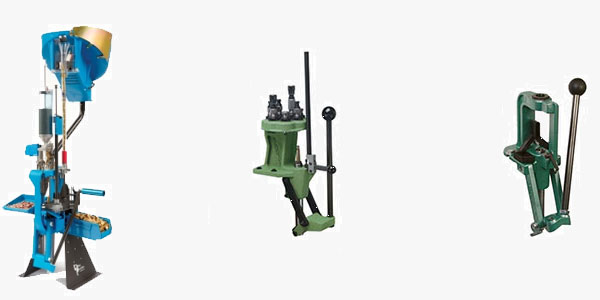
You will need a set of reloading dies for each caliber.
If you buy a set with a carbide sizing die, you will not have to lube straight-walled cases before sizing. They are well worth the investment.
The set shown is from Hornady. The sizing die (in the center) has a gold-colored titanium nitride coating that serves the same purpose as the carbide in other manufacturers' sets - no lube is required with these dies.
If you are loading on a single stage or turret press, you will also need a shell holder for each caliber (the shell holder is on the left in the photo). Some die sets come with a shell holder, but most don't. If you will be loading on a progressive pres, you will need a shellplate. The shell plates are proprietary, and specific to each press. If you have a Dillon press, the shellplate is part of the caliber conversion kit.
Reloading dies have a standard thread of 7/8"-14. Any dies with this thread will fit any press with this thread.
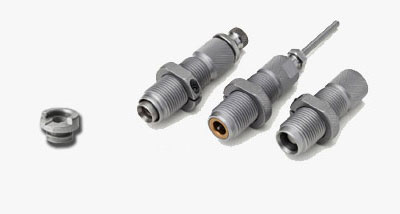
These are the recipe books for your reloads. Get at least three, preferably from the manufacturer of the bullets you'll be most frequently loading.
Some good ones to start are Hornady, Speer, Lyman (especially if you'll be loading cast lead bullets), and Lee.
The Hodgdon website has tons of reloading data for Hodgdon, Winchester, and IMR powders. The Alliant site has some (minimal) data, and the Accurate
site has a good downloadable guide (in PDF).

A reloading scale measures in "grains". One grain is equal to 1/7000th of a pound.
The main purpose of a reloading scale is to weigh powder charges, but it is also useful for checking a sample of any new bullets to verify proper weight.
You can use either a mechanical balance type scale, or an electronic reloading scale. Both have their advantages. Electronic scales are faster, but mechanical scales require no power or batteries, and provide better resolution because you can see when the pointer on the scale is a hair above or below a reading.

Your fired brass cases must be cleaned before running them through your reloading dies.
The two most common methods are dry tumbling with a vibratory bowl cleaner (shown) or wet tumbling using stainless steel media.
Dry tumbling has a lower cost of entry, while wet tumbling might be more cost effective in the long run.
The Frankford Arsenal dry tumbling setup shown includes a tumbler, media separator, tumbler media, and a bottle of case polish (which is not really needed).
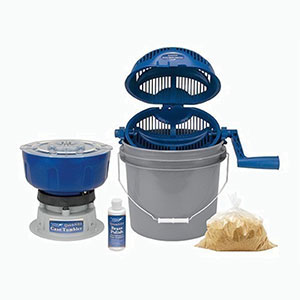
A dial (or digital) caliper is a measuring instrument accurate to roughly 0.001".
You will need it to measure cartridge overall length, case length, and bullet diameter. It will quickly become the most useful measuring tool in your shop. It's hard to reload without one.

If you will be loading on a progressive press, it will probably come with an adjustable powder measure. If you're loading on a single stage or turret press, you will need to buy an adjustable powder measure.
Technically, you don't absolutely need an adjustable powder measure; provided you're willing to weigh every charge by using a dipper to scoop powder into the scale pan, a trickler to dispense up to the desired charge weight, and dump the result into each case through a powder funnel (these items are shown on the right in the photo below). Since this is even slower and more tedious than it sounds, an adjustable powder measure is a very good investment.
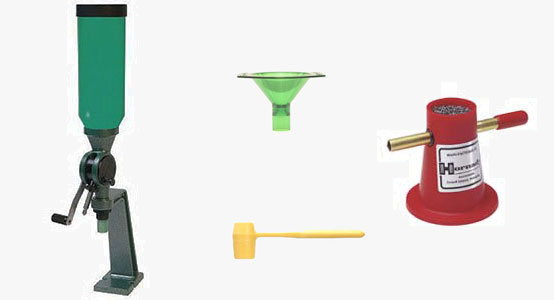
An adjustable powder measure is a device with a hopper to hold the powder, connected to a sliding or rotating dispensing mechanism. The dispensing mechanism is adjustable, allowing it to throw different volumes of powder.
To use the powder measure, first decide on a charge weight, then cycle the measure so that it throws powder into a primed case. Weigh the resulting charge by dumping it into the pan on your reloading scale, then adjust the powder measure until it consistently throws your target charge weight. You can then use it to charge your cases with powder without having to weigh every single charge.
The RCBS measure on the left in the photo features an optional bracket to mount it to the bench. Rifle powder measures (or powder measures with a rifle rotor installed) have the ability to throw larger charges of powder, but may not throw small "pistol-sized" charges consistently. Pistol powder measures (or powder measures with a pistol rotor installed) are precise enough to reliably throw small charges, but lack the capacity to throw charges large enough for many rifle calibers. Check the charge weight range of the powder measure to ensure that it is sized for your application.
Every round you reload will need a new primer. You can prime on your press, with a bench-mounted priming tool, or with a hand tool.
Progressive presses have built-in priming capability. Single stage and turret presses usually come with a simple priming arm that allows you to manually insert primers one-at-a-time. Some of these presses have optional primer dispensing systems to make the task more efficient.
When loading with single stage or turret presses, some reloaders find it more efficient to prime the cases off the press in batches using a hand priming tool (shown) or a bench-mounted priming tool. A bench-mounted tool is easier and less tiring on your hands, but a hand priming tool is quicker. The hand priming tool shown is the RCBS "Universal" hand priming tool, which is the best tool of its kind (except for .45 Colt because the rim on this case it too narrow).
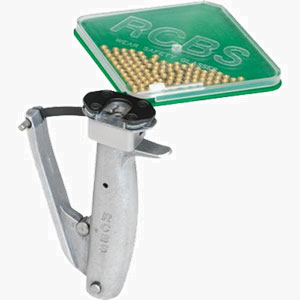
A cartridge gage (sometimes called a "maximum cartridge gage") is a steel cylinder with a hole through the center that is precisely sized to the cartridge dimensions. To use the cartridge gage, you simply place your finished round into the hole in the gage. If the round drops all the way in to the gage, the cartridge will fit even the tightest firearm chamber.
The cartridge gage verifies that the case mouth diameter, base diameter, rim thickness, rim diameter, case length, overall cartridge length and bullet diameter do not exceed their maximum specs.
Instead of a cartridge gage, some reloaders use the barrel from a pistol (or cylinder from a revolver) to check their reloads. This method is fine if you're loading for only one gun, but it doesn't guarantee that the ammo will fit another gun with a tighter chamber.
The photo on the right shows a single-hole, single-caliber gage, as well as a multi-hole gage that can check several calibers. Cartridge gages start at about $20, and are made by Dillon, Lyman, EGW, LE Wilson, and others.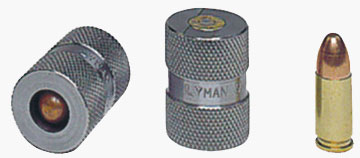
Additional tools and equipment you'll need for reloading bottleneck rifle calibers:
If you've been loading pistol ammo on a progressive or turret press, you probably want to get a robust single stage press for your rifle case prep. By "robust", I mean something that won't flex under load, so inexpensive "C" frame presses are out. Look for an "O" or "D" frame press instead. (They're called O or D because the press frames resemble these letters).
Examples include:The following presses are not traditional O or D frame machines, but they are strong enough to resize rifle cases without excessive deflection:
Why not use just a progressive or turret press?
Rifle case prep involves lubing the cases before resizing, removing the lube after resizing, and (possibly) trimming, chamfering, and deburring.
Since lubing and removing lube must be done off the press, and trimming is best accomplished off the press (so you can chamfer and deburr
the cases) it is impossible to make good rifle ammo start-to-finish in one run through a progressive or turret press. Most progressive
reloaders do their bottleneck case prep on a single stage press; then once prepped, run the cases through the progressive press to load them.
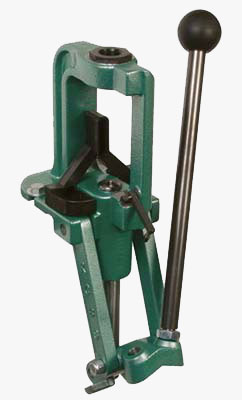
Bottleneck cases stretch to fill the chamber when you fire them, and stretch a little more if they're full-length resized. Load them enough times, and eventually you will have to trim them. Therefore, you will need a trimmer.
There are dozens of different types of trimmers, but I'll cut to the chase: If you have a drill press or are handy enough to rig up a motor to run it, the Trim-It II trimmer (shown on the left in the photo below) is the one you want to get. This device trims, chamfers, and deburrs as quickly as you can stuff cases into it (>500 per hour).
If you want to save money and don't mind spending extra time and effort trimming, then a manual trimmer by L.E. Wilson is the way to go (on the right in the photo below). The Wilson trimmer is also the one to use for oddball calibers that are not compatible with the Trim-It II trimmer, because L.E. Wilson makes trimmer collets for literally hundreds of calibers, many of which I've never even heard of. You need to put it in a vise to use it. It's simple to use - just load a case in the collet, put the collet on the trimmer, and crank the cutter until it stops cutting. Here's a demonstration.
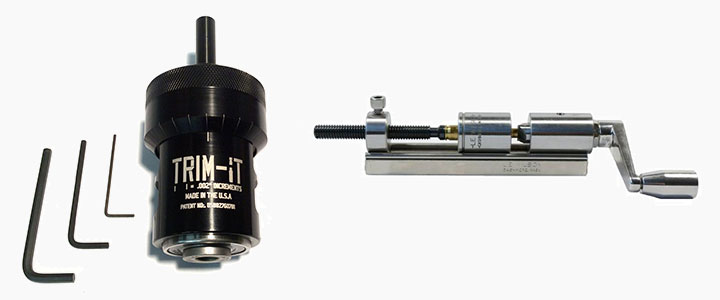
Like most manual trimmers, the L.E. Wilson cuts the top of the case flat, so the case mouth should be chamfered and deburred before loading. This can be done with a simple hand tool called a chamfer/deburring tool (an example from L.E. Wilson is shown in the photo below).
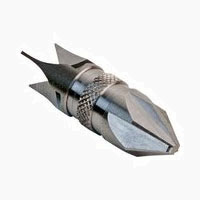
Military (or military-style) ammo often features a crimp to hold the primer in place. The crimp can be a series of 3 or 4 dents called "stakes" around the perimeter of the primer, or a continous annular "lip" on the top edge of the primer pocket. After depriming, all remnants of the crimp must be removed before a new primer can be inserted into the case. If you're planning to reload .223/5.56 and/or 7.62x51 (.308), you should get a tool to remove the crimp. The most common methods for dealing with the crimp are to either cut it away with a deburring bit (like a Weldon bit, on the right), or to swage it flat using a bench-mounted tool like the one from Dillon (shown on the left) or RCBS.
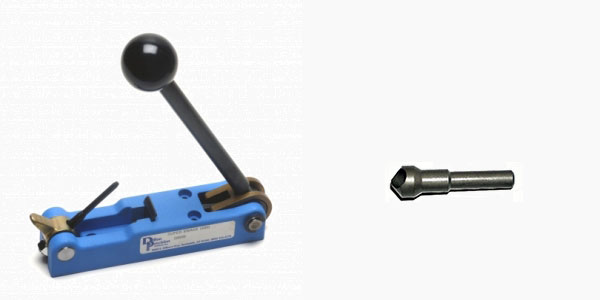
When you full-length resize bottleneck rifle cases, the die pushes back the case shoulder. If the shoulder isn't pushed back far enough, then the distance from the case head to the shoulder (sometimes called the "headspace length") ends up too long, and the rifle's action won't close. If it's too short, the round will either not fire at all or the case will stretch excessively when it is fired.
The amount of shoulder movement is controlled by how deeply the resizing die is set in the press. Move the die closer to the shellholder and the casehead-to-shoulder distance shortens, move the die away from the shell holder and the headspace length get longer.
There are several tools you can use to measure/check the casehead-to-shoulder length on the cases you're sizing to ensure that the sizing die is set up to properly size the cases for your rifle. You'll need to get something like one of these:
- The RCBS Precision Mic (shown on the left) is a caliber-specific tool that allows you to make an absolute measurement of the casehead-to-shoulder
distance. On bottleneck cases that headspace on the shoulder, this is the actual case headspace length.
- The Hornady Headspace Comparator kit (center) is not caliber specific. It allows you to make a relative
measurement of the casehead-to-shoulder distance for a variety of different calibers depending on which insert is installed.
- A case gage (right) allows you to verify that the case head to shoulder distance, case body diameter, and case
length are all within SAAMI specs. Please note that the case gage is different than the cartridge gage described above.
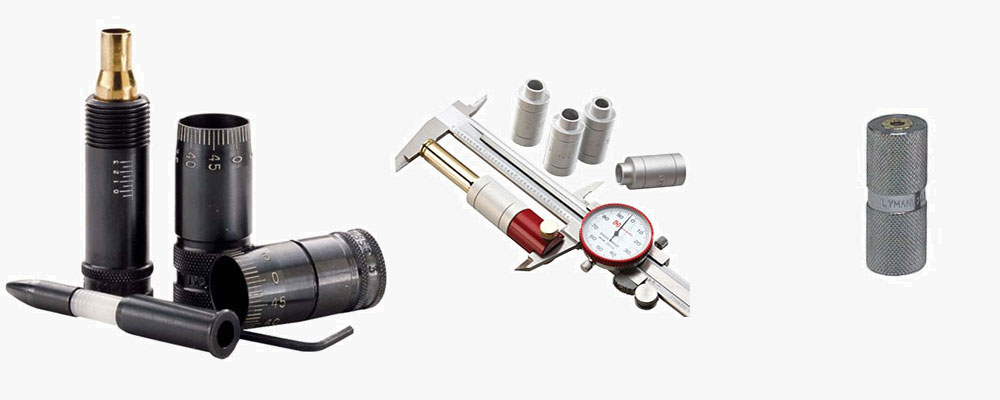
Even if you use carbide dies, bottleneck rifle cases must be lubed before sizing. There are many ways to do this, but experienced reloaders prefer lanolin-based products such as Imperial Sizing Die Wax (on the left) for small batches, and an isopropyl alcohol/lanolin mixture such as the Dillon spray lube (right) for larger quantities.
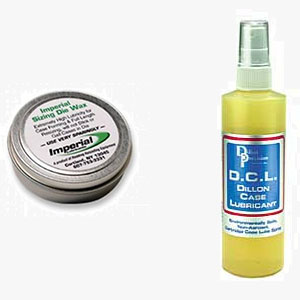
© Copyright 2017 MassReloading.com. All Rights Reserved.